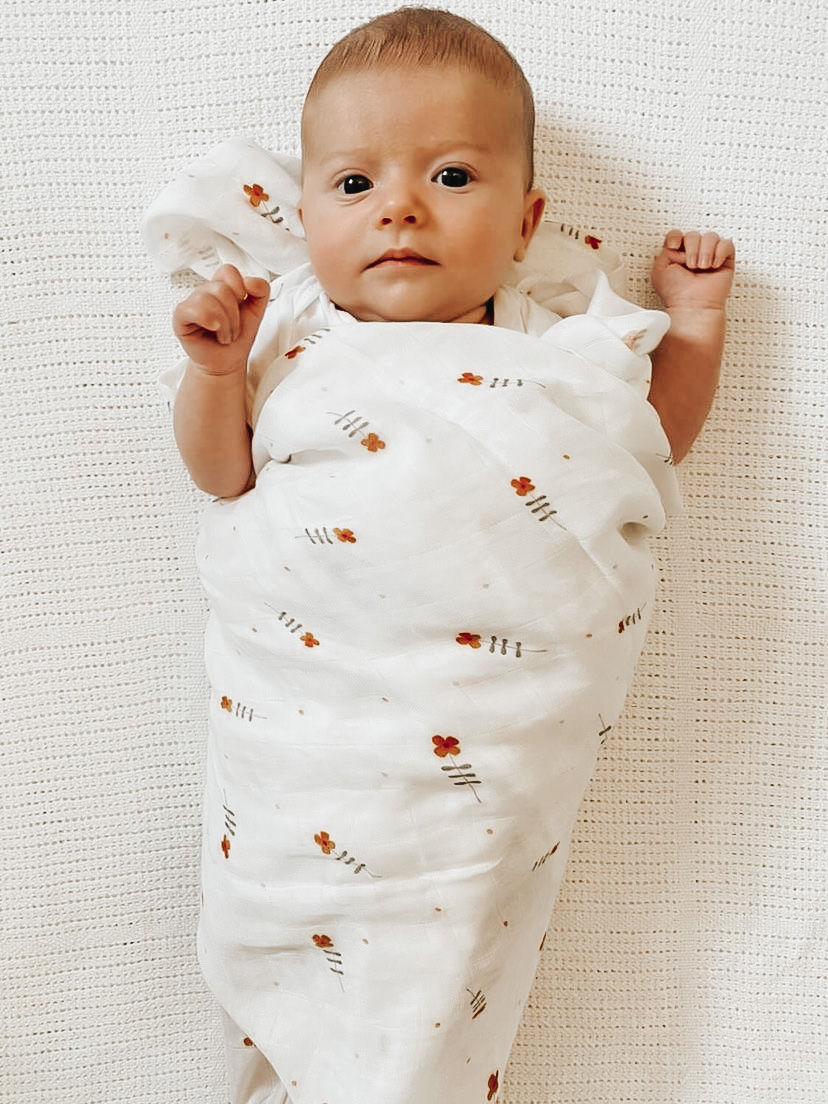Swaddling your baby: benefits, risks and safety tips on how to safely swaddle your little one.
- Noonie Earth

- Oct 26, 2021
- 6 min read
Updated: Nov 18, 2021
Swaddling might sound outdated to some new parents, however, many swaddling parents still say it helps soothe their baby allowing them to sleep better. As Noonie sells high-quality breathable swaddles we wanted to discuss the benefits, risks and share tips for safe swaddling.
You might have seen our Noonie babies wrapped up like cute baby burritos or witnessed the Royal baby Louis’ first TV appearance. If so, you know what a swaddled baby looks like.
Here’s what you need to know about swaddling.
(Noonie products used in image: Classic Car Swaddle Noonie Noddy )
What is swaddling?
The traditional practice of swaddling is the wrapping up of a baby gently in a light, breathable blanket to help soothe them, providing them with security that supports sleep. Swaddling provides newborns with an almost womb-like feeling which can help provide calm during the 4th trimester (the first three months of life).
90 percent of babies in North America are swaddled in the first weeks of life. Wrapping babies to sleep has been around since ancient times. And its impact on babies has been studied for decades or more.
They should only have their body wrapped and not their neck or head.

5 benefits of swaddling your little one.
1. Helps to calm and soothe baby:
Many people say when a baby is swaddled it helps calm their newborn as swaddling provides almost a womb-like environment for your little one, helping them to settle easier and sleep for longer. Disclaimer - there is little research to support these theories.
2. Swaddling protects your baby against their natural startle reflex, which means better sleep for both of you
It’s also thought that swaddling prevents unnecessary wake-ups caused by a baby’s startle reflex. This is because a swaddled baby’s arms and legs will be contained as they’re wrapped gently in a blanket. That means they will be less likely to startle themselves awake with their flailing limbs.
It is becoming a parenting trend to refer to the first three months of your babies life as the fourth trimester. It highlights that the first three months of your newborn life is a complicated transition period for them after they make it to the earth-side. It makes perfect sense that your baby likes to be wrapped gently (not too tightly) so they feel just as they did in the womb.
3. It may help a colicky baby
One of the most difficult things I have experienced as a parent is a baby with colic, and I am sure any parent who has experienced a baby with colic will agree with me. I felt totally helpless in my ability as a parent to soothe my crying baby. I found swaddling really helped calm my firstborn who suffered from colic. It had an almost therapeutic effect on him. I later found out this was because the swaddle would be applying light pressure to my newborn's belly. The pressure and cocoon-like feeling mimicked the womb and provided relief to my baby. Who knew!
4. It helps to prevent SIDS by keeping unnecessary items like pillows, blankets out of your babies crib.
Swaddling, when done properly, is effective and safe. Swaddling helps maintain the supine position during sleep (sleeping on their back). Infants placed to sleep on their stomachs are at an increased risk of SIDs.
Babies which like to be placed on their front are usually used to the slight pressure on their stomach which can be provided by a swaddle. Adding a little pressure and security to your baby. - (Do not wrap them tightly, they need to still be able to move and their hips should be in a frog-like position with the ability to kick out).
Babies should therefore always be placed to sleep on their back, never on their stomach or side. By swaddling your baby in the supine position (on their back), you help your baby maintain this safe sleep position. For a baby who is not yet capable of rolling over on their own, swaddling is safer than a loose blanket.
You should stop swaddling when your baby begins to show signs of being able to roll over from back to front, break free from the baby swaddle wrap, or when the swaddle becomes disruptive to sleep.
5. Swaddling helps your baby to regulate its temperature
Swaddling your baby in a high-quality breathable swaddle such as one of our Noonie Swaddle can help maintain the optimal temperature ensuring that your little one doesn't overheat.
Avoid "double swaddling" or using a blanket that is too warm.
Double Swaddling with two different items (swaddle and grow bag, or two swaddles) and multiple layers can cause your baby to overheat which can increase the risk of SIDs. A breathable fabric, like the bamboo & organic cotton, swaddle from Noonie will help keep your baby warm and snug without the danger of overheating.
Experts also recommend maintaining a comfortable room temperature of around 65-70 degrees Fahrenheit 18 - 21 degrees. After being swaddled, your baby's skin should feel comfortable to touch and not too warm. See our TOG Ratings & what to wear guide for safe sleepwear against temperatures.
(Noonie products used in image: Small Flower Swaddle Noonie Noddy )

Risks of swaddling
We want to be transparent with our customers when they are looking to swaddle their babies. Despite our Noonie swaddles being multi-purpose, we wanted to highlight any risks which can come when a baby is not swaddled correctly.
There are two things that can cause complications when swaddling isn't carried out correctly.
1. Natural positioning
Some evidence suggests that tightly swaddling a baby could increase their chance of developing hip dysplasia (a developmental problem with a baby’s hip joint). You can help lower this risk by making sure you don’t swaddle your baby too tightly. You can also use hip-healthy swaddling techniques to reduce your baby’s risk of hip dysplasia.
Make sure your baby is able to move their hips and knees freely to kick.
A newborn baby’s legs should be able to fall into a natural position in a frog style.
WATCH THIS VIDEO ON HOW TO SAFELY SWADDLE.
2. Swaddling after the baby shows signs of rolling.
There are a few studies that address safety concerns with swaddling. In one 2016 review of studies, the results showed that swaddling was connected to a “small but significant” risk of sudden infant death syndrome or SIDS. This risk increased with age when swaddled babies were able to roll onto their sides or stomachs to sleep.
How long can I safely swaddle my baby for?
Swaddling should only be introduced when your baby is a newborn to provide the transition through the 4th trimester (the first three months of your babies life). As soon as they show signs that they’re learning to roll over or they can already rollover, you need to transition them away from swaddling. This is so they can use their hands and arms freely to adjust their head position if they roll over onto their side or front.
Your baby could start learning to roll over as early as around two or three months old.
Safely Swaddle rules to follow
Use thin materials
Do not swaddle above the shoulders
Never put a swaddled baby to sleep on their front
Do not swaddle too tight
Check the baby’s temperature to ensure they do not get too hot
Stop swaddling once your baby starts to show signs of rolling
Helpful video links
helpful links
Pampers - How to swaddle a baby
Lullaby Trust - Safety and Swaddling
Healthy Children - swaddling: is it safe?
Products featured:
References
Pampers - How to Swaddle
NHS (2018) Sudden infant death syndrome (SIDS). Available at: https://www.nhs.uk/conditions/sudden-infant-death-syndrome-sids/ [Accessed 13th September 2018].
Ockwell-Smith S. (2012) The fourth trimester – AKA why your newborn is only happy in your arms. Available at: https://sarahockwell-smith.com/2012/11/04/the-fourth-trimester-aka-why-your-newborn-baby-is-only-happy-in-your-arms/ [Accessed 13th September 2018].
The Lullaby Trust (2016) Rates of sudden infant death syndrome go down to lowest on record but baby charity says more lives could be saved. Available at: https://www.lullabytrust.org.uk/rates-of-sudden-infant-death-syndrome-go-down-to-lowest-on-record-but-baby-charity-says-more-lives-could-be-saved/ [Accessed 13th September 2018].
The Lullaby Trust (2018) Safe swaddling. Available at: https://www.lullabytrust.org.uk/safer-sleep-advice/swaddling-slings/ [Accessed 13th September 2018].
The Lullaby Trust (2018) What is sudden infant death syndrome (SIDS)? Available at: https://www.lullabytrust.org.uk/safer-sleep-advice/what-is-sids/ [Accessed 13th September 2018].
NCT - Swaddling a baby: the benefits, the risks and seven safely tips: Available at:
Medical opinion on whether swaddling is a good practice or not is divided. So, if you’re considering swaddling your baby, make sure you always follow safe swaddling guidelines to protect your little one.




Comments